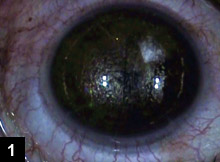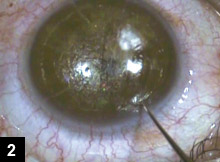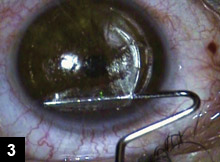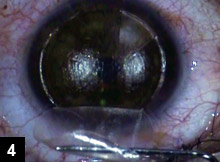Low energy can help create a femtosecond flap over previous RK
A surgeon explains how the procedure was performed on a previously myopic RK patient who now had compound hyperopic astigmatism.
Radial keratotomy was a popular procedure for the correction of myopia in the past. There were a great number of success stories, but unfortunately, the long-term stability of the procedure became an issue.
Now, in our current LASIK centers, we often encounter patients who were previous myopes who underwent RK and are now overcorrected. These typically are highly motivated patients who desire emmetropia again. The challenge has been how to successfully treat them.
The options available now are PRK, lens-based surgery/ICLs, or LASIK. PRK performed with the use of mitomycin C has been a safe and effective option for many patients. It is limited by the speed of recovery, patient comfort and some predictability issues, especially in hyperopic treatments.
IOL and ICL surgery also has been successful, but it is more invasive and expensive, and today’s formulas are not accurate enough to achieve emmetropia in the majority of patients.
Flap risk
LASIK has always been looked at as the treatment option of choice by many, but it too has its risks. Most of the risks involve flap creation. Mechanical devices put a significant amount of stress on the RK incisions and can lead to splitting of even free pieces of the flap. Femtosecond lasers have been tried too, but the physics behind some of the lasers lead to tissue coagulation, vertical gas breakthrough and splitting of the incisions.
We began using a new femtosecond laser called the Femto-LDV by Ziemer. This laser has a wide numerical aperture and a low amount of energy per spot. This combination leads to a tightly focused laser that reaches the threshold for optical breakdown at low energies. In turn, this leads to small cavitation bubbles compared with other femtosecond lasers. This unique feature was what led us to believe that the Femto-LDV could be used in RK cases to create a LASIK flap without mechanical stresses and without the risks of tissue coagulation or vertical gas breakthrough.
 A 52-year-old patient who had undergone eight-incision RK in both eyes 10 years ago for myopia, now had compound hyperopic astigmatism in both eyes. He had no arcuate incisions, and all his RK incisions were well healed. |
 The flap lift was performed with a spatula after opening the edge for 2 clock hours with a Sinskey hook. |
|
 The lift was easily performed with only minor tissue resistance under one of the eight RK incisions, especially at the edge. |
 The flap resistance was easily overcome and lifted without any splitting of the incisions. |
|
LASIK after RK
In this example, we present a 52-year-old patient who had undergone eight-incision RK in both eyes 10 years ago for myopia. He now had compound hyperopic astigmatism in both eyes. He had no arcuate incisions, and all his RK incisions were well healed (Figure 1). He consented to LASIK in both eyes with femtosecond flap creation.
To ensure easy lifting of the femtosecond flap, especially at the border and directly under the incisions, the speed of the femto-pass was reduced by 0.5 seconds from our standard settings. This slower speed allows more spots to be placed during the pass and the edge creation and subsequently easier lifting. The Femto-LDV has such a low energy per spot that the overlapping of the spots does not create enough heat to cause the tissue coagulation that you might get if you tried this with the other femtosecond platforms.
The flap lift was performed with a spatula after opening the edge for 2 clock hours with a Sinskey hook (Figure 2). The lift was easily performed with only minor tissue resistance under one of the eight RK incisions, especially at the edge (Figure 3).
The flap resistance was easily overcome and lifted without any splitting of the incisions (Figure 4). The treatment was performed, and emmetropia was achieved at the postop visits.
In summary, femtosecond flap creation over RK can be safely performed with the right laser and technique. Using a laser with a large numerical aperture, low energy and a small spot size can reduce or eliminate the risks of tissue coagulation and vertical gas breakthrough, and can provide a lift easy enough to avoid splitting the RK incisions.

- N. Timothy Peters, MD, can be reached at Clear Advantage Vision Correction Center, 155 Borthwick Ave., Suite 200 East, Portsmouth, NH 03801; 603-501-5000; e-mail: tpeters@globalv.com. Dr. Peters is a consultant to Bausch & Lomb. He has no financial interests in Ziemer.
